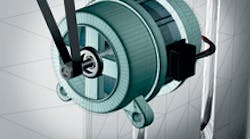Authored by: Edited by Jessica Shapiro Key points Resources |
Look around your house and chances are you’ll see a fractional-horsepower motor (FHP). Actually, you’re more likely to hear one. FHPs are found in a variety of devices, including refrigerators, vacuum cleaners, washing machines, and coffee makers. And they share a common feature: They create noise.
These appliances’ motor vibrations contribute to domestic noise pollution. For example, the average vacuum cleaner is as loud as a tractor 50-ft away. Because those using vacuums have to endure the noise in confined spaces — sometimes for prolonged periods — they may receive potentially harmful noise doses. Researchers have correlated excessive noise and vibration with increased stress levels, negative moods, and hearing loss.
Excessive vibrations also speed wear in the appliances and waste energy. This is becoming a greater concern as consumers base purchasing decisions on Energy Star and other efficiency ratings. In the European Union, for example, products must display energy efficiency and consumption, operating cost, and noise specs. So manufacturers of FHPs are paying as much attention to reducing noise, vibration, and harshness (NVH) as they do to cost competitiveness and energy efficiency.
Quieting equipment
One way to cut NVH without adding bulk is to add bearing mounts. These fix bearings in their intended positions within FHP motors so they cause minimal vibration. Bearing mounts can be press-fit units, adhesives, or tolerance rings.
Press fits, also called interference fits, mean mating components press together and create friction that holds bearings in place. The tight fit calls for precise tolerances and results in a stiff assembly.
The downside to press-fit units is that they provide little damping for motor NVH. In fact, they transmit it to the assembly. In addition, tight tolerances may drive up machining and manufacturing costs.
Adhesives for mounting bearings are relatively inexpensive. However, mounting adhesives may use volatile solvents that cause odors and health problems, and they may deteriorate over time. Most adhesive assemblies also call for tight tolerances for a thin, consistent bondline. And although some thicker adhesives have elastomeric properties that improve damping performance, most adhesive bearing mounts transmit NVH through the assembly.
Tolerance-ring realities
Tolerance rings work differently from press-fit and adhesive bearing mounts. They generate radial spring forces that hold mating components in place. And protrusions around their circumferences absorb motor vibrations.
Because they minimize vibration transfer between bearings and the housing, tolerance rings cut noise in appliances with motors over a range of speeds. Engineers can tailor ring thickness and geometry to get a bearing-mount stiffness with the best transmissibility ratio, the percentage of vibrations that go through the assembly. And because rings can be fine-tuned, housing tolerances can be relaxed.
Tolerance rings are usually carbon or stainless steel, but can be made from other alloys, including nickel-chromium, nickel-copper, nickel-iron-chromium, cobalt-chromium-nickel, and copper-beryllium. Tolerance-ring manufacturers can also heat treat metals to get the right material hardness and elasticity.
Rings can be housing variable (HV) — meaning they don’t form a complete circle, and they compress for a self-retaining fit in the ID of the bearing bore — or shaft variable (SV) — meaning they stretch to install with a self-retaining fit over a shaft’s OD. Tabbed rings have protrusions that keep them from “walking out” despite strong vibrations. Duplex rings have multiple bands of waves for stiffer performance without tighter machining tolerances.
Engineers can choose from free, centered, or piloted tolerance-ring fitting arrangements. Free arrangements have no axial support other than from mating components. Rings in this arrangement undergo axial loading.
Tolerance rings for centered arrangements require grooves in the bearing housing or shaft to capture the ring axially. This simplifies assembly and protects the ring from excessive radial and shock loads. Piloted arrangements have similar advantages, but they use a step rather than a groove, so they cost less to machine.
Each wave of a tolerance ring exerts spring force toward the center of the shaft or circumference of the bore, so rings have a natural tendency to center bearings and shafts. Eccentricity is usually held to 2 to 3% of radial clearance.
A correctly designed tolerance ring will retain positive retention force throughout appliances’ operating-temperature range. At the same time, because bearings, housings, and rings have different coefficients of thermal expansion, slightly heating the bearing assembly lets technicians disassemble the bearing with reasonable force.
Tolerance ring 101 where F = force (N), K = spring constant (N/mm), and c = displacement (mm). K is influenced by the material’s modulus and thickness; wave dimensions like pitch, width, shoulder shape, thinning, and root and crest radii; and plannish width and thickness. Of these, for a given wave shape, the two major factors are thickness and wave pitch. So K can also be represented by: where E = elastic modulus for the material (kN/mm2), w = width (mm), t = thickness (mm), and p = wave pitch (mm). The cubic power relationship permits a wide range of spring stiffness. Engineers design rings for an application by varying geometry, material thickness, hardness, and other properties to create an appropriate spring constant, retention forces, and slip torques. Rings typically exhibit elastic properties when wave height is compressed 3 to 7%. Light-duty rings, specifically those for mounting bearings, can have elastic limits that permit up to 50% wave-height compression with a usable range of 20 to 40%. The radial load a ring can take is given by: where FR = radial load (N), n = number of waves, and c = compression of waves (mm). And torque T (N-mm) on a spring of diameter d (mm) is: Bearing-mount applications typically involve tolerance rings designed to have the minimum spring compression that will retain bearings when the assembly has its maximum clearance. This approach means the rest of the spring compression range is available to handle external radial loads, machining tolerances, or dimensional changes due to thermal expansion of mating components. |
